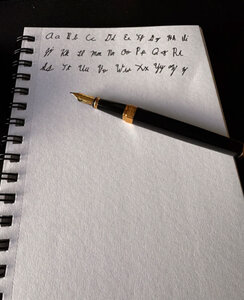The Advantages of Using Fountain Pens
I physically write my notes and schedule down as opposed to typing them out. I remember things better when I physically write them out. I can bring a notebook/pen anywhere — as opposed to my computer/phone. I’ve tried switching to note taking software like Obsidian and writing my own note taking script to do note taking and scheduling for a period of time, but have not found much success. Anyhow, this article I wrote is on why I use fountain pens — they remove the barrier to get things from my mind to a piece of paper and make the writing process more enjoyable.
My experience with fountain pens is that — although they are worse than a ballpoint in regards to weather resistance — they are smoother to write with compared to a ballpoint pen and they compliment cursive handwriting quite well. Fountain pens also tend to have a much better build quality than ballpoints as they are typically refilled with ink as opposed to being thrown out; they are made to last. I much prefer using a fountain pen over a ballpoint pen because of their smoothness to write with, their craftsmanship, and them giving me the ability to style my handwriting.
When pressure is applied to a fountain pen on a piece of paper what is happening is that the ’nib’ (the split metal point at the end of a fountain pen) is forced open to allow ink to be dragged across the page with capillary action. How much pressure is applied to a fountain pen determines how thick the ink lines are (more pressure leads to the metal splitting wider leading to wider lines being drawn). This allows for more variation when writing with a fountain pen as different parts of letters can be thicker than others to give a certain effect.

There is a lower threshold of pressure required for the fountain pen to work. This makes them perfect for when writing in cursive where the pen is having more continuous contact with the paper. I sometimes write for a long time using my fountain pens and my wrists don’t get tired. When I write with a ballpoint my wrists get tired early, so I typically switch to writing in block letters.
When I write with a fountain pen in cursive I feel that writing the next sentence is going to be fun — as opposed to being an uncomfortable chore that I feel when writing with a ballpoint pen.
Fountain pens are produced to be reusable with either refillable cartilages or with a plunger mechanism built into the pen. Disposable fountain pens do exist, but their writing quality is degraded due to higher tolerances needed to make a good nib. The cheapest decent fountain pens run around $20 (e.g. Lamy Safari, Pilot Metropolitan) and are made with steel nibs; there is no problem writing with them compared to more expensive options. My first fountain pen was a $20 Pilot that used cartilages.
The cost of more expensive fountain pens comes down to the fountain pen being constructed with more premium materials, with greater craftsmanship, and being associated with a luxury brand. More expensive fountain pens are made with a gold nib with a more expensive body made with precious metals and/or wood/ivory. Some fountain pen enthusiasts see their pen as a piece of jewelry and start looking to buy from European luxury brands like Montblanc, Caran d’Ache, and Montegrappa that sell pens that reach into the $1,000 and $10,000 range.
I own a few high-end Waterman pens (one of them a gift from my father), but I view high-end and luxury pens as excessive for someone just looking to write. I do enjoy using a gold nib, but that may just be due to me getting used to writing with one for so long. The pen that I’ve used for the past several years for daily writing is a waterman exception pen that was probably not the most fugal purchase at the time.
I’ll wrap up my thoughts on fountain pens with places I would not use them. I don’t use a fountain pen at work as I’m often outside and getting wet — fountain pens leak all over the place when the nib comes into contact with a liquid and the ink that fountain pens use are highly soluble in water. Fountain pens also requires the correct paper to work ideally — the ink in a fountain pen will bleed through paper that is too thin and will smudge on paper that is too glossy. Fountain pens should not be used on planes as the pressure difference between the ink reservoir in the pen and the cabin pressure will cause the ink to leak out. Obviously, I would also not use a expensive fountain pen somewhere that I think it has a high likelihood to be stolen.
